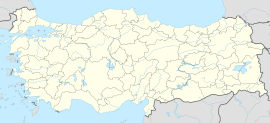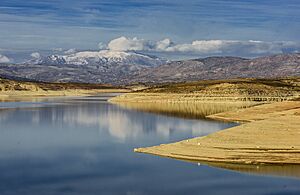Sason facts for kids
Quick facts for kids
Sason
|
|
|---|---|
 |
|
| Country | Turkey |
| Province | Batman |
| District | Sason |
| Population
(2021)
|
12,696 |
| Time zone | TRT (UTC+3) |
| Postal code |
72500
|
Sason is a town located in the Batman Province of Turkey. It serves as the main town for the Sason District. As of 2021, about 12,696 people live in Sason. The town was once known by the name Kabilcevz.
Contents
What's in a Name? Understanding Sason's History
The name Sason comes from an old historical area called Sasun. According to an old Armenian story, the name Sasun (which used to be Sanasunk) is linked to a person named Sanasar. Sanasar was the son of an Assyrian king named Sennacherib.
Sanasar is said to have moved to the area around Mount Sim. This place was then called Sanasunk, meaning "Sanasar's family" or "Sanasar's descendants." This is because his family lived there.
Why Was it Called Kabilcevz?
The town's older name, Kabilcevz, comes from an Arabic word, jawz. This word means 'walnut'. In Turkish, it's ceviz. The town was called this because there were many walnut trees growing in the area.
A Look Back: Sason's Past
During the time of the Ottoman Empire, Sason was known as Kabilcevz. It was part of a larger area called Hazzo-Kabilcevz. This area was inside the Sasun district, which was part of the Bitlis vilayet (a type of province). Sometimes, it was also part of the Kulp district.
In 1914, Sason was a village where both Armenian and Kurdish families lived. Records show there were about 105 Kurdish families and 45 Armenian families. Sadly, many Armenian people living in the village were forced to leave and lost their lives during a very difficult time in history. In 1925, the settlement officially became the center of the Sason District.
Who Lives in Sason?
As of 2021, the town of Sason has a population of 12,696 people. This number helps us understand how many residents call Sason home.
Exploring Sason's Culture and Landmarks
The Sason area is rich in history and has many interesting old ruins. You can also find several historical water fountains, which are still used today. Some of these fountains include Sevek Çeşmesi, Nabuhan Çeşmesi, Hapyenk Çeşmesi, and Ağde Çeşmesi.
There is also a special burial site called Şehan. This site is a türbe, which is a tomb for a holy person. Every July, people gather at Şehan for celebrations. The town also used to have an Armenian church named Surp Stepanos.
See also
 In Spanish: Sasun para niños
In Spanish: Sasun para niños



